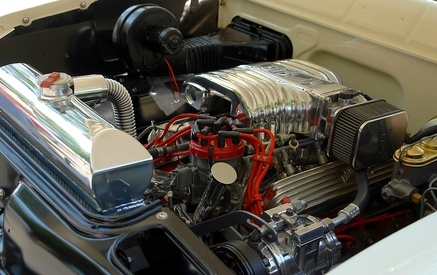
Overheating problems in any car or truck requires serious attention fast. With extreme overheating conditions, engine components can break down in a domino effect and ruin multiple systems at once. Byproducts of serious overheating include: sluggish acceleration response, bad gas mileage, galled (or melted) bearings, piston sleeve and ring failure, rubber hose and plastic sensor melting, bursting head gaskets, and sometimes engine compartment fires. Overheating problems manifest themselves in four senses: touch, smell, noise, and sight. An observant driver can catch the problem early, which can save thousands of dollars in repair.
Watch your temperature gauge in the vehicle for signs that the needle is entering the yellow caution zone, or climbing higher into the red zone. A steady red indicator dash light means a general hot condition.
Caution: Check a cool engine. Never pull caps or hoses while the engine is running hot!
Low to medium overheating (yellow zone) during all driving conditions can be attributed to a low radiator level. If the level is substantially low, it means a leak is present or the water has evaporated over time. Remove the radiator cap and visually inspect the level. The coolant level should be up to the top of the cap neck. Fill if necessary.
A vehicle that runs constantly hot, but makes no noise or loses water, could be a rusted out and clogged radiator core (the core removes heat by dispensation and air flow). If the coolant appear rust-colored or filled with debris, it needs to be hot-tanked or replaced. Bird feathers, mud, insects and other object collect on the front of radiator. They should be removed with a high pressure water nozzle.

The overflow reservoir is located in the engine compartment. Usually made of plastic and holding a gallon of coolant, it is designed to reclaim coolant from pressure exiting the radiator during engine shutoff. Lines etched or stamped on the side of reservoirs indicate the proper level, often marked "hot" and "cold." According to engine condition, fill the reservoir with coolant to the proper level line. Check the small rubber hose that leads from it to the radiator neck for tightness and leakage.

Check both upper and lower radiator hoses for condition and tightness. A puddle underneath them flags a leak. Replace cracked or leaking hoses. Most cracks and leaks will appear at the radiator neck. A hose that has "bloated" and increased in size means it has lost its inner wall strength. Replace all hoses that have any deformity.
Check the thermostat (mounted on the front of the engine, connected to the upper radiator hose) for leaks, white crust and rust. Stuck thermostats will many times cause a very loud thumping or knocking noise that comes from the radiator. When a thermostat sticks, the engine overheats within minutes because the cooling system is completely closed off. Applying a wooden stick to the radiator will let you feel the knocking vibrations. Replace the thermostat and gasket.
Look at your exhaust tail pipe while the engine is running at operating temperature. If you see water spraying or dripping from it (in profuse amounts), this can pinpoint a bad head gasket. The engine will misfire at times with this condition. Any spark plug that has a rusted electrode indicates water has entered the cylinder. Remove the radiator cap, start the engine, and look at the water (relieve the pressure first). If you see bubbles rising, this means compression gas has entered a water passage--evidence that a head gasket has failed. Also look for steam or smoke in the engine compartment. A "plap-plap" noise coming from the engine can be caused by a blown head gasket.
Locate the water pump on the front side of the engine block. If the fan shaft moves in either direction it means the interior bearing has failed due to lack of lubrication or rust. Most water pumps had a pressure relief hole on their underside. Any water dripping from this hole means the bearing has worn and the seal has disintegrated. Replace the water pump with these symptoms.
The water pump driving (fan) belt should have no cracks and be tight around its pulley. Tighten any loose belt, leaving 1/2 inch slack. Replace belts that look frayed or cracked. A squealing noise coming from the belt indicates looseness and wear.
With newer cars equipped with radiator-mounted electronic fans, instead of a water pump-driven fan, make sure it activates when the engine reaches operating temperature. If the fan motor does not come on with a warm or hot engine, it means the electrical relay or fan motor is bad. Isolate the failed component and replace.
A fan clutch is located on many water pump-equipped vehicles. At rest, the fan blade should show resistence or drag when pressure is applied to rotate it. A fan that rotates slowy, lags with momentum, or fails to spin means that the clutch dampner has worn out and should be replaced.
Check the ignition timing, making sure it is set to manufacturers' specifications. Overly advanced timing (over specs) can overheat the engine.